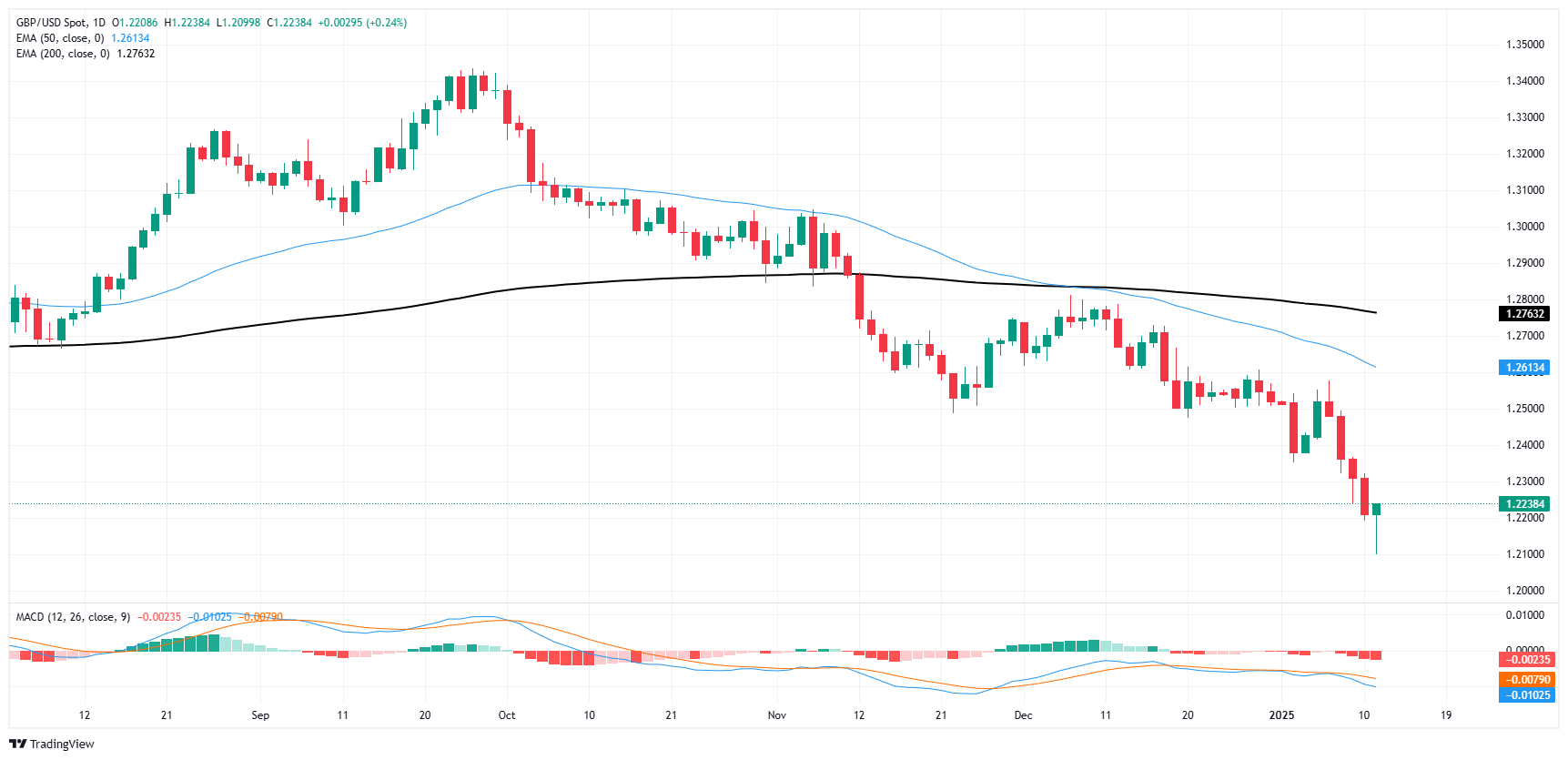GBP/USD roils on Monday, testing new lows before recovering to flat
- GBP/USD spun in a quick circle on Monday, dipping to new lows but returning to flat.
- GBP bullish sentiment is able to recover near-term losses, but not much else.
- UK and US inflation data due this week to provide plenty of ammunition for traders.
GBP/USD churned as markets rebalance their interest rate expectations through the rest of the year, sending Cable to a fresh 15-month low and tapping the 1.2100 handle before reversing the day’s losses and ending close to where it started at 1.2230.
It’s a quiet start to the week, but a crescendo of inflation data on both the US and UK side of the economic calendar will give traders plenty of material to chew through as they try to nail down a rate differential forecast heading through the first quarter. The Federal Reserve (Fed) is broadly expected to stand pat on interest rates through the first half of the year, while the Bank of England (BoE) is expected to have to choose between holding steady on interest rates in the face of still-high inflation, or risking an inflationary spark in order to shore up the UK’s floundering economy with further rate cuts.
US Producer Price Index (PPI) figures kick the week’s meaningful data docket off on Tuesday, which is expected to rise to 3.7% YoY in December versus the previous 3.4%. Wednesday brings UK Consumer Price Index (CPI) inflation which is also expected to accelerate in the near-term, forecast to rise to 0.4% MoM versus the previous 0.1%.
US CPI inflation, also due on Wednesday, is forecast to tick higher to 2.8% from 2.7%, and US Retail Sales activity is slated for Thursday, with UK Retail Sales rounding out the high-impact data docket for this week.
GBP/USD price forecast
GBP/USD continues to grind out a bearish path down the charts, with the pair exploring its lowest bids in over a year. Although bidding pressure is stepping in on swing lows, it’s getting hard not to notice that those swing lows continue to pierce through old technical levels on a regular basis.
The next key technical barrier to further declines will be late 2023’s technical support zone just north of 1.2000.
GBP/USD daily chart
Pound Sterling FAQs
The Pound Sterling (GBP) is the oldest currency in the world (886 AD) and the official currency of the United Kingdom. It is the fourth most traded unit for foreign exchange (FX) in the world, accounting for 12% of all transactions, averaging $630 billion a day, according to 2022 data. Its key trading pairs are GBP/USD, also known as ‘Cable’, which accounts for 11% of FX, GBP/JPY, or the ‘Dragon’ as it is known by traders (3%), and EUR/GBP (2%). The Pound Sterling is issued by the Bank of England (BoE).
The single most important factor influencing the value of the Pound Sterling is monetary policy decided by the Bank of England. The BoE bases its decisions on whether it has achieved its primary goal of “price stability” – a steady inflation rate of around 2%. Its primary tool for achieving this is the adjustment of interest rates. When inflation is too high, the BoE will try to rein it in by raising interest rates, making it more expensive for people and businesses to access credit. This is generally positive for GBP, as higher interest rates make the UK a more attractive place for global investors to park their money. When inflation falls too low it is a sign economic growth is slowing. In this scenario, the BoE will consider lowering interest rates to cheapen credit so businesses will borrow more to invest in growth-generating projects.
Data releases gauge the health of the economy and can impact the value of the Pound Sterling. Indicators such as GDP, Manufacturing and Services PMIs, and employment can all influence the direction of the GBP. A strong economy is good for Sterling. Not only does it attract more foreign investment but it may encourage the BoE to put up interest rates, which will directly strengthen GBP. Otherwise, if economic data is weak, the Pound Sterling is likely to fall.
Another significant data release for the Pound Sterling is the Trade Balance. This indicator measures the difference between what a country earns from its exports and what it spends on imports over a given period. If a country produces highly sought-after exports, its currency will benefit purely from the extra demand created from foreign buyers seeking to purchase these goods. Therefore, a positive net Trade Balance strengthens a currency and vice versa for a negative balance.
